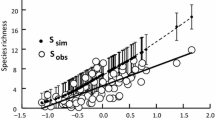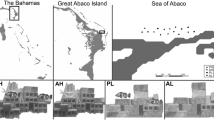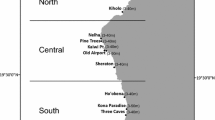Abstract
Small patch reefs can harbor many reef fishes because most fishes have a drifting larval phase to randomly disperse over patchy habitats. We examined the species–area relationship (SAR) of damselfish (Pomacentridae) assemblages over 84 small patch reefs (0.05–45.4 m2) using an enlarged section of a high-resolution color aerial photograph as a field map (1/2500) in a shallow coral reef shore zone (<2 m deep, 3.6 ha, Shiraho Reef, Ishigaki Island, Japan). This study confirmed that the logarithmic function is better than other functions (including the power function) to explain the SAR in this scale. Actual species richness (24) over the entire study site was much higher than the species richness (15.4) extrapolated from the regression line in semi-log space. Better estimates were obtained using random placement models and computer simulations. These results suggest that several small patch reefs are likely to have higher species richness than a single large reef of equivalent area at the study site. The total number of individuals of the four most abundant territorial herbivores increased almost linearly with patch reef area, but that of other species roughly increased with the square root of the area. While no territorial species were found in the smallest reefs, the large territorial herbivore, Hemiglyphidodon plagiometopon, was abundant and had negative effects on species richness in large reefs. Although the well-known single-large-or-several-small (SLOSS) debate has largely been settled, this dichotomy can be important in places where territorial herbivores do not occupy the smallest reefs.





Similar content being viewed by others
References
Abelson A, Shlesinger Y (2002) Comparison of the development of coral and fish communities on rock-aggregated artificial reefs in Eilat, Red Sea. ICES J Mar Sci 59:122–126
Allen GR (1975) Anemonefishes: their classification and biology, 2nd edn. TFH Publications, Neptune City
Allen GR (1991) Damselfishes of the world. Mergus Publications, Melle
Ault TR, Johnson CR (1998) Spatially and temporally predictable fish communities on coral reefs. Ecol Monogr 68:25–50
Bell JD, Galzin R (1984) Influence of live coral cover on coral-reef fish communities. Mar Ecol Prog Ser 15:265–274
Belmaker J, Ben-Moshe N, Ziv Y, Shashar N (2007) Determinants of the steep species-area relationship of coral reef fishes. Coral Reefs 26:103–112
Ceccarelli DM (2007) Modification of benthic communities by territorial damselfishes: a multi-species comparison. Coral Reefs 26:853–866
Ceccarelli DM, Jones GP, McCook LJ (2001) Territorial damselfishes as determinants of the structure of benthic communities on coral reefs. Oceanogr Mar Biol Annu Rev 39:355–389
Chabanet P, Ralambondrainy H, Amanieu M, Faure R, Galzin R (1997) Relationships between coral reef substrata and fish. Coral Reef 16:93–102
Chittaro PM (2002) Species–area relationships for coral reef fish assemblages of St. Croix, US Virgin Islands. Mar Ecol Prog Ser 233:253–261
Coleman BD (1981) On the random placement and species–area relations. Math Biosci 54:191–215
Connor EF, McCoy ED (1979) The statistics and biology of the species–area relationship. Am Nat 113:791–833
Crawley MJ, Harral JE (2001) Scale dependence in plant biodiversity. Science 291:864–868
Dengler J (2009) Which function describes the species-area relationship best? A review and empirical evaluation. J Biogeogr 36:728–744
Drakare S, Lennon JJ, Hillebrand H (2006) The imprint of the geographical, evolutionary and ecological context on species-area relationships. Ecol Lett 9:215–227
Grober-Dunsmore R, Kranzer TK, Lindberg WJ, Beets J (2007) Reef fish and habitat relationships in a Caribbean seascape: the importance of reef context. Coral Reefs 26:201–216
Hata H, Kato M (2002) Weeding by the herbivorous damselfish Stegastes nigricans in nearly monocultural algae farms. Mar Ecol Prog Ser 237:227–231
Hata H, Kato M (2006) A novel obligate cultivation mutualism between damselfish and Polysiphonia algae. Biol Lett 2:593–596
Hattori A (2002) Small and large anemonefishes can coexist using the same patchy resources on a coral reef, before habitat destruction. J Anim Ecol 71:824–831
Hattori A, Kobayashi M (2007) Configuration of small patch reefs and population abundance of a resident reef fish in a complex coral reef landscape. Ecol Res 22:575–581
Hattori A, Kobayashi M (2009) Incorporating fine-scale seascape composition in an assessment of habitat quality for the giant sea anemone Stichodactyla gigantea in a coral reef shore zone. Ecol Res 24:415–422
He F, Legendre P (2002) Species diversity patterns derived from species–area models. Ecology 83:1185–1198
Hughes TP, Bellwood DR, Folke C, Steneck RS, Wilson J (2005) New paradigms for supporting the resilience of marine ecosystems. Trends Ecol Evol 20:380–386
Irlandi EA, Ambrose WG, Orlando BA (1995) Landscape ecology and marine environment: how spatial configuration of seagrass habitat influences growth and survival of the bay scallop. Oikos 72:307–313
Kobayashi M, Hattori A (2006) Spacing pattern and body size composition of the protandrous anemonefish Amphiprion frenatus inhabiting colonial host sea anemones. Ichthyol Res 53:1–6
Lomolino MV (1994) An evaluation of alternative strategies for building networks of natural reserves. Biol Conserv 69:243–249
Lowe-McConnell RH (1987) Ecological studies in tropical fish communities. Cambridge University Press, Cambridge
Luckhurst BE, Luckhurst K (1978) Analysis of the influence of substrate variables on coral reef fish communities. Mar Biol 49:317–323
Masuda H, Amaoka K, Araga C, Ueno T, Yoshino T (1984) The fishes of the Japanese Archipelago. Tokai University Press, Tokyo
McClanahan TR (1994) Kenyan coral reef lagoon fish: effects of fishing, substrate complexity, and sea urchins. Coral Reefs 13:231–241
McCormick MI (1994) Comparison of field methods for measuring surface topography and their associations with a tropical reef fish assemblage. Mar Ecol Prog Ser 112:87–96
McGuinness KA (1984) Species–area relations of communities on intertidal boulders: testing the null hypothesis. J Biogeogr 11:439–456
Mumby PJ, Harborne AR (2006) A seascape-level perspective of coral reef ecosystems. In: Côté IM, Reynolds JD (eds) Coral reef conservation. Cambridge University Press, Cambridge, pp 78–114
Neigel JE (2003) Species–area relationships and marine conservation. Ecol Appl 13:s138–s145
Norman MD, Jones GP (1984) Determinants of territory size in the pomacentrid reef fish, Parma victoriae. Oecologia 61:60–69
Pittman SJ, McAlpine CA, Pittman KM (2004) Linking fish and prawns to their environment: a hierarchical landscape approach. Mar Ecol Prog Ser 283:233–254
Planes S, Jones GP, Thorrold SR (2009) Larval dispersal connects fish populations in a network of marine protected areas. Proc Natl Acad Sci USA. doi:10.1073/pnas. 0808007106
Primack RB (2004) A primer of conservation biology, 3rd edn. Sinauer Associates Inc., Sunderland
Pullin AS (2002) Conservation biology. Cambridge University Press, Cambridge
R Development Core Team (2006) R: a language and environment for statistical computing. R Foundation for Statistical Computing, Vienna, Austria. http://www.R-project.org
Robbins BD, Bell SS (1994) Seagrass landscapes: a terrestrial approach to the marine subtidal environment. Trends Ecol Evol 9:301–304
Rosenzweig ML (1995) Species diversity in space and time. Cambridge University Press, Cambridge
Rosenzweig ML (2004) Applying species–area relationships to the conservation of species diversity. In: Lomolino MV, Heaney LR (eds) Frontiers of biogeography: new directions in the geography of nature. Sinauer Association Inc., Sunderland, pp 325–343
Saenz-Agudelo P, Jones GP, Thorrold SR, Planes S (2009) Estimating connectivity in marine populations: an empirical evaluation of assignment tests and parentage analysis under different gene flow scenarios. Mol Ecol. doi:10.1111/j.1365-294X.2009.04109.x
Sale PF (1991) The ecology of fishes on coral reefs. Academic Press, San Diego
Sale PF, Steel WJ (1986) Random placement and the distribution of fishes among coral patch reefs. Mar Ecol Prog Ser 28:165–174
Scheiner SM (2003) Six types of species–area curves. Glob Ecol Biogeogr 12:441–447
Scheiner SM (2004) A mélange of curves—further dialogue about species–area relationships. Glob Ecol Biogeogr 13:479–484
Simberloff D, Gotelli N (1984) Effects of insularization on plant species richness in the prairie-forest ecotone. Biol Conserv 29:27–46
Tamura H, Nadaoka K, Paringit EC (2007) Hydrodynamic characteristics of a fringing coral reef on the east coast of Ishigaki Island, southwest Japan. Coral Reefs 26:17–34
Tilman D, Kareiva P (1997) Spatial ecology: the role of space in population dynamics and interspecific interactions. Princeton University Press, Princeton
Tittensor DP, Micheli F, Nyström M, Worm B (2007) Human impacts on the species–area relationship in reef fish assemblages. Ecol Lett 10:760–772
Tjørve E (2003) Shapes and functions of species–area curves: a review of possible models. J Biogeogr 30:827–835
Tjørve E, Tjørve KMC (2008) The species–area relationship, self-similarity, and the true meaning of the z-value. Ecology 89:3528–3533
Turner WE, Tjørve E (2005) Scale-dependence in species–area relationships. Ecography 28:721–730
Turner W, Leitner WA, Rosenzweig ML (2000) Ws2m.exe. http://eebweb.arizona.edu/diversity
Turner MG, Gardner RH, O’Neill RV (2001) Landscape ecology in theory and practice: pattern and process. Springer, Berlin Heidelberg New York
Wilson S, Bellwood DR (1997) Cryptic dietary components of territorial damselfishes (Pomacentridae, Labroidei). Mar Ecol Prog Ser 153:299–310
Acknowledgments
We are grateful to Y. Yanagisawa, D. Price and anonymous reviewers for their valuable advice regarding the manuscript. M. Migita and Y. Mizukami gave us technical advice on computer programming. F. Iwasaki provided valuable information on references. This work was supported in part by a grant-in aid for Science Research from the Japan Ministry of Education, Science, Culture, and Sports (Nos. 20570020, 16570014). A. H. is a Guest Scientist at the Center for Ecological Research, Kyoto University.
Author information
Authors and Affiliations
Corresponding author
About this article
Cite this article
Hattori, A., Shibuno, T. The effect of patch reef size on fish species richness in a shallow coral reef shore zone where territorial herbivores are abundant. Ecol Res 25, 457–468 (2010). https://doi.org/10.1007/s11284-009-0675-5
Received:
Accepted:
Published:
Issue Date:
DOI: https://doi.org/10.1007/s11284-009-0675-5




